
- •General Information
- •Before Servicing
- •Model Identification
- •General Specifications
- •Unit Conversion Table
- •Periodic Maintenance
- •Periodic Maintenance Chart
- •Torque and Locking Agent
- •Specifications
- •Special Tools
- •Periodic Maintenance Procedures
- •Fuel System (DFI)
- •Throttle Control System Inspection
- •Engine Vacuum Synchronization Inspection
- •Idle Speed Inspection
- •Idle Speed Adjustment
- •Fuel Hose Inspection (fuel leak, damage, installation condition)
- •Cooling System
- •Coolant Level Inspection
- •Radiator Hose and Pipe Inspection (coolant leak, damage, installation condition)
- •Engine Top End
- •Valve Clearance Inspection
- •Valve Clearance Adjustment
- •Air Suction System Damage Inspection
- •Clutch
- •Clutch Operation Inspection
- •Wheels/Tires
- •Air Pressure Inspection
- •Wheel/Tire Damage Inspection
- •Tire Tread Wear Inspection
- •Wheel Bearing Damage Inspection
- •Final Drive
- •Drive Chain Lubrication Condition Inspection
- •Drive Chain Slack Inspection
- •Drive Chain Slack Adjustment
- •Wheel Alignment Inspection
- •Drive Chain Wear Inspection
- •Chain Guide Wear Inspection
- •Brakes
- •Brake Fluid Leak (Brake Hose and Pipe) Inspection
- •Brake Hose and Pipe Damage and Installation Condition Inspection
- •Brake Fluid Level Inspection
- •Brake Pad Wear Inspection
- •Brake Operation Inspection
- •Brake Light Switch Operation Inspection
- •Suspension
- •Front Forks/Rear Shock Absorber Operation Inspection
- •Front Fork Oil Leak Inspection
- •Rear Shock Absorber Oil Leak Inspection
- •Rocker Arm Operation Inspection
- •Tie-Rod Operation Inspection
- •Steering
- •Steering Play Inspection
- •Steering Play Adjustment
- •Steering Stem Bearing Lubrication
- •Steering Damper Oil Leak Inspection
- •Electrical System
- •Lights and Switches Operation Inspection
- •Headlight Aiming Inspection
- •Sidestand Switch Operation Inspection
- •Engine Stop Switch Operation Inspection
- •Others
- •Chassis Parts Lubrication
- •Bolts, Nuts and Fasteners Tightness Inspection
- •Replacement Parts
- •Air Cleaner Element Replacement
- •Fuel Hose Replacement
- •Coolant Change
- •Radiator Hose and O-ring Replacement
- •Engine Oil Change
- •Oil Filter Replacement
- •Brake Hose and Pipe Replacement
- •Brake Fluid Change
- •Master Cylinder Rubber Parts Replacement
- •Caliper Rubber Parts Replacement
- •Spark Plug Replacement
- •Fuel System (DFI)
- •Exploded View
- •DFI System
- •DFI Parts Location
- •Specifications
- •Special Tools and Sealant
- •DFI Servicing Precautions
- •DFI Servicing Precautions
- •Troubleshooting the DFI System
- •Outline
- •Inquiries to Rider
- •DFI System Troubleshooting Guide
- •Self-Diagnosis
- •Self-diagnosis Outline
- •Self-diagnosis Procedures
- •Service Code Reading
- •Service Code Erasing
- •Backups
- •Main Throttle Sensor (Service Code 11)
- •Main Throttle Sensor Removal/Adjustment
- •Main Throttle Sensor Input Voltage Inspection
- •Main Throttle Sensor Output Voltage Inspection
- •Main Throttle Sensor Resistance Inspection
- •Inlet Air Pressure Sensor #1 (Service Code 12)
- •Inlet Air Pressure Sensor #1 Removal
- •Inlet Air Pressure Sensor #1 Installation
- •Inlet Air Pressure Sensor #1 Output Voltage Inspection
- •Inlet Air Temperature Sensor (Service Code 13)
- •Inlet Air Temperature Sensor Removal/Installation
- •Inlet Air Temperature Sensor Resistance Inspection
- •Water Temperature Sensor (Service Code 14)
- •Water Temperature Sensor Removal/Installation
- •Water Temperature Sensor Resistance Inspection
- •Inlet Air Pressure Sensor #2 (Service Code 16)
- •Inlet Air Pressure Sensor #2 Removal
- •Inlet Air Pressure Sensor #2 Installation
- •Inlet Air Pressure Sensor #2 Output Voltage Inspection
- •Crankshaft Sensor (Service Code 21)
- •Crankshaft Sensor Removal/Installation
- •Crankshaft Sensor Resistance Inspection
- •Crankshaft Sensor Peak Voltage Inspection
- •Speed Sensor (Service Code 24)
- •Speed Sensor Removal/Installation
- •Speed Sensor Inspection
- •Speed Sensor Input Voltage Inspection
- •Speed Sensor Output Voltage Inspection
- •Gear Position Switch (Service Code 25)
- •Gear Position Switch Removal/Installation
- •Gear Position Switch Resistance Inspection
- •Gear Position Switch Output Voltage Inspection
- •Vehicle-down Sensor (Service Code 31)
- •Vehicle-down Sensor Removal
- •Vehicle-down Sensor Installation
- •Vehicle-down Sensor Input Voltage Inspection
- •Vehicle-down Sensor Output Voltage Inspection
- •Subthrottle Sensor (Service Code 32)
- •Subthrottle Sensor Removal/Adjustment
- •Subthrottle Sensor Input Voltage Inspection
- •Subthrottle Sensor Output Voltage Inspection
- •Subthrottle Sensor Resistance Inspection
- •Oxygen Sensor - not activated (Service Code 33 (Equipped Models))
- •Oxygen Sensor Removal/Installation
- •Oxygen Sensor Inspection
- •Exhaust Butterfly Valve Actuator Sensor (Service Code 34)
- •Exhaust Butterfly Valve Actuator Sensor Removal/Installation
- •Immobilizer Amplifier (Service Code 35 (Equipped Models))
- •Antenna Resistance Inspection
- •Amplifier Input Voltage Inspection
- •Blank Key Detection (Service Code 36 (Equipped Models))
- •User Key Inspection
- •ECU Communication Error (Service Code 39)
- •ECU Communication Line Inspection
- •Stick Coils #1, #2, #3, #4 (Service Code 51, 52, 53, 54)
- •Stick Coil Removal/Installation
- •Stick Coil Primary Winding Resistance Inspection
- •Stick Coil Input Voltage Inspection
- •Radiator Fan Relay (Service Code 56)
- •Radiator Fan Relay Removal/Installation
- •Radiator Fan Relay Inspection
- •Subthrottle Valve Actuator (Service Code 62)
- •Subthrottle Valve Actuator Removal
- •Subthrottle Valve Actuator Inspection
- •Subthrottle Valve Actuator Resistance Inspection
- •Exhaust Butterfly Valve Actuator (Service Code 63)
- •Exhaust Butterfly Valve Actuator Removal
- •Exhaust Butterfly Valve Actuator Installation
- •Exhaust Butterfly Valve Actuator Inspection
- •Air Switching Valve (Service Code 64)
- •Air Switching Valve Removal/Installation
- •Air Switching Valve Inspection
- •Oxygen Sensor Heater (Service Code 67 (Equipped Models))
- •Oxygen Sensor Heater Removal/Installation
- •Oxygen Sensor Heater Resistance Inspection
- •Oxygen Sensor - Incorrect Output Voltage (Service Code 94 (Equipped Models))
- •Oxygen Sensor Removal/Installation
- •Oxygen Sensor Inspection
- •Warning Indicator Light (LED)
- •Light (LED) Inspection
- •ECU Identification
- •ECU Removal
- •ECU Installation
- •ECU Power Supply Inspection
- •DFI Power Source
- •ECU Fuse Removal
- •ECU Fuse Installation
- •ECU Fuse Inspection
- •ECU Main Relay Removal/Installation
- •ECU Main Relay Inspection
- •Fuel Line
- •Fuel Pressure Inspection
- •Fuel Flow Rate Inspection
- •Fuel Pump
- •Fuel Pump Removal
- •Fuel Pump Installation
- •Fuel Pump Operation Inspection
- •Fuel Pump Operating Voltage Inspection
- •Pressure Regulator Removal
- •Fuel Filter Cleaning
- •Fuel Injectors
- •Primary Fuel Injector Removal/Installation
- •Secondary Fuel Injector Removal/Installation
- •Fuel Injector Audible Inspection
- •Fuel Injector Resistance Inspection
- •Fuel Injector Power Source Voltage Inspection
- •Fuel Injector Output Voltage Inspection
- •Fuel Injector Fuel Line Inspection
- •Throttle Grip and Cables
- •Free Play Inspection
- •Free Play Adjustment
- •Cable Installation
- •Cable Lubrication
- •Throttle Body Assy
- •Idle Speed Inspection/Adjustment
- •Synchronization Inspection/Adjustment
- •Throttle Body Assy Removal
- •Throttle Body Assy Installation
- •Throttle Body Assy Disassembly
- •Throttle Body Assy Assembly
- •Nozzle Assy
- •Nozzle Assy Removal
- •Nozzle Assy Installation
- •Nozzle Assy Disassembly
- •Nozzle Assy Assembly
- •Air Cleaner
- •Air Cleaner Element Removal/Installation
- •Air Cleaner Element Inspection
- •Air Cleaner Oil Draining
- •Air Cleaner Housing Removal
- •Air Cleaner Housing Installation
- •Air Cleaner Housing Disassembly
- •Air Cleaner Housing Assembly
- •Air Line
- •Air Inlet Duct Removal
- •Air Inlet Duct Installation
- •Fuel Tank
- •Fuel Tank Removal
- •Fuel Tank Installation
- •Fuel Tank Inspection
- •Fuel Tank Cleaning
- •Evaporative Emission Control System (CAL, SEA and TH Models)
- •Parts Removal/Installation
- •Hose Inspection
- •Separator Inspection
- •Separator Operation Test
- •Canister Inspection
- •Cooling System
- •Exploded View
- •Coolant Flow Chart
- •Specifications
- •Special Tools
- •Coolant
- •Coolant Deterioration Inspection
- •Coolant Level Inspection
- •Coolant Draining
- •Coolant Filling
- •Pressure Testing
- •Cooling System Flushing
- •Coolant Reserve Tank Removal
- •Coolant Reserve Tank Installation
- •Water Pump
- •Water Pump Removal
- •Water Pump Installation
- •Water Pump Inspection
- •Water Pump Impeller Disassembly/Assembly
- •Water Pump Impeller Inspection
- •Water Pump Housing Disassembly
- •Water Pump Housing Assembly
- •Mechanical Seal Inspection
- •Radiator
- •Radiator and Radiator Fan Removal
- •Radiator and Radiator Fan Installation
- •Radiator Inspection
- •Radiator Cap Inspection
- •Radiator Filler Neck Inspection
- •Thermostat
- •Thermostat Removal
- •Thermostat Installation
- •Thermostat Inspection
- •Hoses and Pipes
- •Hose Installation
- •Hose Inspection
- •Water Temperature Sensor
- •Water Temperature Sensor Removal/Installation
- •Water Temperature Sensor Inspection
- •Engine Top End
- •Exploded View
- •Exhaust System Identification
- •Specifications
- •Special Tools and Sealant
- •Clean Air System
- •Air Suction Valve Removal
- •Air Suction Valve Installation
- •Air Suction Valve Inspection
- •Air Switching Valve Removal
- •Air Switching Valve Installation
- •Air Switching Valve Operation Test
- •Air Switching Valve Unit Test
- •Clean Air System Hose Inspection
- •Cylinder Head Cover
- •Cylinder Head Cover Removal
- •Cylinder Head Cover Installation
- •Camshaft Chain Tensioner
- •Camshaft Chain Tensioner Removal
- •Camshaft Chain Tensioner Installation
- •Camshaft, Camshaft Chain
- •Camshaft Removal
- •Camshaft Installation
- •Camshaft, Camshaft Cap Wear Inspection
- •Camshaft Runout Inspection
- •Cam Wear Inspection
- •Camshaft Chain Removal
- •Cylinder Head
- •Cylinder Compression Measurement
- •Cylinder Head Removal
- •Cylinder Head Installation
- •Cylinder Head Warp Inspection
- •Valves
- •Valve Clearance Inspection
- •Valve Removal
- •Valve Installation
- •Valve Guide Removal
- •Valve Guide Installation
- •Valve-to-Guide Clearance Measurement (Wobble Method)
- •Valve Seat Inspection
- •Valve Seat Repair
- •Throttle Body Assy Holder
- •Throttle Body Assy Holder Removal
- •Throttle Body Assy Holder Installation
- •Muffler
- •Muffler Body Removal
- •Muffler Body Installation
- •Premuffler Chamber Removal
- •Premuffler Chamber Installation
- •Exhaust Pipe Removal
- •Exhaust Pipe Installation
- •Exhaust Butterfly Valve Cable Removal
- •Exhaust Butterfly Valve Cable Installation
- •Clutch
- •Exploded View
- •Specifications
- •Special Tool and Sealant
- •Clutch Lever and Cable
- •Clutch Lever Free Play Inspection
- •Clutch Lever Free Play Adjustment
- •Cable Removal
- •Cable Installation
- •Cable Lubrication
- •Clutch Lever Installation
- •Clutch Cover
- •Clutch Cover Removal
- •Clutch Cover Installation
- •Release Shaft Removal
- •Release Shaft Installation
- •Clutch Cover Disassembly
- •Clutch Cover Assembly
- •Clutch
- •Clutch Removal
- •Clutch Installation
- •Spring Plate Free Play Measurement
- •Spring Plate Free Play Adjustment
- •Clutch Plate, Wear, Damage Inspection
- •Clutch Plate Warp Inspection
- •Clutch Spring Free Length Measurement
- •Clutch Housing Finger Inspection
- •Clutch Housing Spline Inspection
- •Damper Cam Inspection
- •Engine Lubrication System
- •Exploded View
- •Engine Oil Flow Chart
- •Specifications
- •Special Tools and Sealant
- •Engine Oil and Oil Filter
- •Oil Level Inspection
- •Engine Oil Change
- •Oil Filter Replacement
- •Oil Pan Removal
- •Oil Pan Installation
- •Oil Pressure Relief Valve
- •Oil Pressure Relief Valve Removal
- •Oil Pressure Relief Valve Installation
- •Oil Pressure Relief Valve Inspection
- •Oil Pump
- •Oil Pump Removal
- •Oil Pump Installation
- •Oil Pump Drive Gear Removal
- •Oil Pump Drive Gear Installation
- •Oil Pump Drive Gear Shaft Removal
- •Oil Pump Drive Gear Shaft Installation
- •Oil Cooler
- •Oil Cooler Removal
- •Oil Cooler Installation
- •Oil Cooler/Oil Filter Case Removal
- •Oil Cooler/Oil Filter Case Installation
- •Oil Pressure Measurement
- •Oil Pressure Measurement
- •Oil Pressure Switch
- •Oil Pressure Switch Removal
- •Oil Pressure Switch Installation
- •Engine Removal/Installation
- •Exploded View
- •Special Tool
- •Engine Removal/Installation
- •Engine Removal
- •Engine Installation
- •Crankshaft/Transmission
- •Exploded View
- •Specifications
- •Special Tools and Sealants
- •Crankcase
- •Crankcase Splitting
- •Crankcase Assembly
- •Crankshaft and Connecting Rods
- •Crankshaft Removal
- •Crankshaft Installation
- •Connecting Rod Removal
- •Connecting Rod Installation
- •Crankshaft/Connecting Rod Cleaning
- •Connecting Rod Bend Inspection
- •Connecting Rod Twist Inspection
- •Connecting Rod Big End Side Clearance Inspection
- •Connecting Rod Big End Bearing Insert/Crankpin Wear Inspection
- •Crankshaft Side Clearance Inspection
- •Crankshaft Runout Inspection
- •Pistons
- •Piston Removal
- •Piston Installation
- •Cylinder (Upper Crankcase) Wear Inspection
- •Piston Wear Inspection
- •Piston Ring, Piston Ring Groove Wear Inspection
- •Piston Ring Groove Width Inspection
- •Piston Ring Thickness Inspection
- •Piston Ring End Gap Inspection
- •Starter Idle Gear and Starter Clutch
- •Starter Idle Gear Removal
- •Starter Idle Gear Installation
- •Starter Clutch Removal
- •Starter Clutch Installation
- •Starter Clutch Disassembly
- •Starter Clutch Assembly
- •Starter Clutch Inspection
- •Transmission
- •Transmission Assy Removal
- •Transmission Assy Disassembly
- •Transmission Assy Assembly
- •Transmission Assy Installation
- •Transmission Shaft Removal
- •Transmission Shaft Installation
- •Transmission Shaft Disassembly
- •Transmission Shaft Assembly
- •Shift Drum and Fork Removal
- •Shift Drum and Fork Installation
- •Shift Drum Disassembly
- •Shift Drum Assembly
- •Shift Fork Bending Inspection
- •Shift Fork/Gear Groove Wear Inspection
- •Shift Fork Guide Pin/Drum Groove Wear Inspection
- •Gear Dog and Gear Dog Hole Damage Inspection
- •External Shift Mechanism
- •Shift Pedal Removal
- •Shift Pedal Installation
- •External Shift Mechanism Removal
- •External Shift Mechanism Installation
- •External Shift Mechanism Inspection
- •Wheels/Tires
- •Exploded View
- •Specifications
- •Special Tools
- •Wheels (Rims)
- •Front Wheel Removal
- •Front Wheel Installation
- •Rear Wheel Removal
- •Rear Wheel Installation
- •Wheel Inspection
- •Axle Inspection
- •Balance Inspection
- •Balance Adjustment
- •Balance Weight Removal
- •Balance Weight Installation
- •Tires
- •Air Pressure Inspection/Adjustment
- •Tire Inspection
- •Tire Removal
- •Tire Installation
- •Tire Repair
- •Hub Bearing
- •Hub Bearing Removal
- •Hub Bearing Installation
- •Hub Bearing Inspection
- •Hub Bearing Lubrication
- •Final Drive
- •Exploded View
- •Specifications
- •Special Tools
- •Drive Chain
- •Drive Chain Slack Inspection
- •Drive Chain Slack Adjustment
- •Wheel Alignment Inspection/Adjustment
- •Drive Chain Wear Inspection
- •Drive Chain Lubrication
- •Drive Chain Guide Wear Inspection
- •Drive Chain Removal
- •Sprocket, Coupling
- •Engine Sprocket Removal
- •Engine Sprocket Installation
- •Rear Sprocket Removal
- •Rear Sprocket Installation
- •Coupling Installation
- •Coupling Bearing Removal
- •Coupling Bearing Installation
- •Coupling Bearing Inspection
- •Coupling Bearing Lubrication
- •Coupling Damper Inspection
- •Sprocket Wear Inspection
- •Rear Sprocket Warp Inspection
- •Brakes
- •Exploded View
- •Specifications
- •Special Tools
- •Brake Lever, Brake Pedal
- •Brake Lever Position Adjustment
- •Brake Pedal Position Inspection
- •Brake Pedal Position Adjustment
- •Brake Pedal Removal
- •Brake Pedal Installation
- •Calipers
- •Front Caliper Removal
- •Rear Caliper Removal
- •Caliper Installation
- •Front Caliper Disassembly
- •Front Caliper Assembly
- •Rear Caliper Disassembly
- •Rear Caliper Assembly
- •Caliper Fluid Seal Damage Inspection
- •Caliper Dust Seal Damage Inspection
- •Caliper Piston and Cylinder Damage Inspection
- •Rear Caliper Holder Shaft Wear Inspection
- •Brake Pads
- •Front Brake Pad Removal
- •Front Brake Pad Installation
- •Rear Brake Pad Removal
- •Rear Brake Pad Installation
- •Brake Pad Wear Inspection
- •Master Cylinder
- •Front Master Cylinder Removal
- •Front Master Cylinder Installation
- •Rear Master Cylinder Removal
- •Rear Master Cylinder Installation
- •Front Master Cylinder Disassembly
- •Rear Master Cylinder Disassembly
- •Master Cylinder Assembly
- •Master Cylinder Inspection (Visual Inspection)
- •Brake Disc
- •Brake Disc Removal
- •Brake Disc Installation
- •Brake Disc Wear Inspection
- •Brake Disc Warp Inspection
- •Brake Fluid
- •Brake Fluid Level Inspection
- •Brake Fluid Change
- •Brake Line Bleeding
- •Brake Hose
- •Brake Hose Removal/Installation
- •Brake Hose Inspection
- •Suspension
- •Exploded View
- •Specifications
- •Special Tools
- •Front Fork
- •Rebound Damping Force Adjustment
- •Compression Damping Force Adjustment
- •Spring Preload Adjustment
- •Front Fork Removal (Each Fork Leg)
- •Front Fork Installation (Each Fork Leg)
- •Front Fork Oil Change
- •Front Fork Disassembly
- •Front Fork Assembly
- •Inner Tube Inspection
- •Dust Seal Inspection
- •Spring Tension Inspection
- •Rear Shock Absorber
- •Rebound Damping Force Adjustment
- •Compression Damping Force Adjustment
- •Spring Preload Adjustment
- •Rear Shock Absorber Removal
- •Rear Shock Absorber Installation
- •Rear Shock Absorber Inspection
- •Rear Shock Absorber Scrapping
- •Swingarm
- •Swingarm Removal
- •Swingarm Installation
- •Swingarm Bearing Removal
- •Swingarm Bearing Installation
- •Swingarm Bearing, Sleeve Inspection
- •Swingarm Bearing Lubrication
- •Tie-Rod, Rocker Arm
- •Tie-Rod Removal
- •Tie-Rod Installation
- •Rocker Arm Removal
- •Rocker Arm Installation
- •Tie-Rod and Rocker Arm Bearing Removal
- •Tie-Rod and Rocker Arm Bearing Installation
- •Tie-Rod/Rocker Arm Bearing, Sleeve Inspection
- •Tie-Rod/Rocker Arm Bearing Lubrication
- •Steering
- •Exploded View
- •Specifications
- •Special Tools
- •Steering
- •Steering Inspection
- •Steering Adjustment
- •Steering Damper
- •Damping Force Adjustment
- •Steering Damper Removal
- •Steering Damper Installation
- •Steering Damper Oil Leak Inspection
- •Steering Stem
- •Stem, Stem Bearing Removal
- •Stem, Stem Bearing Installation
- •Steering Stem Bearing Lubrication
- •Steering Stem Warp Inspection
- •Stem Cap Deterioration, Damage Inspection
- •Handlebar
- •Handlebar Removal
- •Handlebar Installation
- •Frame
- •Exploded View
- •Seats
- •Front Seat Removal
- •Front Seat Installation
- •Rear Seat Removal
- •Rear Seat Installation
- •Fairings
- •Lower Fairing Removal
- •Lower Fairing Installation
- •Lower Inner Fairing Removal
- •Lower Inner Fairing Installation
- •Upper Fairing Assembly Removal
- •Upper Fairing Assembly Installation
- •Center Fairing Removal
- •Center Fairing Installation
- •Upper Fairing Removal
- •Upper Fairing Installation
- •Upper Center Fairing Removal
- •Upper Center Fairing Installation
- •Upper Inner Fairing Removal
- •Upper Inner Fairing Installation
- •Center Inner Fairing Removal
- •Center Inner Fairing Installation
- •Inner Fairing Removal
- •Inner Fairing Installation
- •Fairing Cover Removal
- •Fairing Cover Installation
- •Side Covers
- •Side Cover Removal
- •Side Cover Installation
- •Seat Covers
- •Seat Cover Removal
- •Seat Cover Installation
- •Upper Seat Cover Installation (Only on Ninja ZX-6R MONSTER ENERGY® Model)
- •Fenders
- •Front Fender Removal
- •Front Fender Installation
- •Flap and Rear Fender Removal
- •Flap and Rear Fender Installation
- •Frame
- •Rear Frame Rear Removal
- •Rear Frame Rear Installation
- •Rear Frame Front Removal
- •Rear Frame Front Installation
- •Frame Inspection
- •Windshield
- •Windshield Removal
- •Windshield Installation
- •Guard
- •Mud Guard Removal
- •Mud Guard Installation
- •Sidestand
- •Sidestand Removal
- •Sidestand Installation
- •Electrical System
- •Exploded View
- •Specifications
- •Special Tools and Sealant
- •Parts Location
- •Wiring Diagram (US, CAL and CA Models)
- •Wiring Diagram (Other than US, CAL and CA Models)
- •Precautions
- •Electrical Wiring
- •Wiring Inspection
- •Battery
- •Battery Removal
- •Battery Installation
- •Battery Activation
- •Precautions
- •Interchange
- •Charging Condition Inspection
- •Refreshing Charge
- •Charging System
- •Alternator Cover Removal
- •Alternator Cover Installation
- •Stator Coil Removal
- •Stator Coil Installation
- •Alternator Rotor Removal
- •Alternator Rotor Installation
- •Charging Voltage Inspection
- •Alternator Inspection
- •Regulator/Rectifier Inspection
- •Ignition System
- •Crankshaft Sensor Removal
- •Crankshaft Sensor Installation
- •Crankshaft Sensor Inspection
- •Crankshaft Sensor Peak Voltage Inspection
- •Stick Coil Removal
- •Stick Coil Installation
- •Stick Coil Inspection
- •Stick Coil Primary Peak Voltage Inspection
- •Spark Plug Removal
- •Spark Plug Installation
- •Spark Plug Condition Inspection
- •Interlock Operation Inspection
- •IC Igniter Inspection
- •Electric Starter System
- •Starter Motor Removal
- •Starter Motor Installation
- •Starter Motor Disassembly
- •Starter Motor Assembly
- •Brush Inspection
- •Commutator Cleaning and Inspection
- •Armature Inspection
- •Brush Lead Inspection
- •Right-hand End Cover Assembly Inspection
- •Starter Relay Inspection
- •Lighting System
- •Headlight Beam Horizontal Adjustment
- •Headlight Beam Vertical Adjustment
- •Headlight Bulb Replacement
- •City Light Bulb Replacement
- •Headlight Removal/Installation
- •Tail/Brake Light (LED) Removal/Installation
- •License Plate Light Bulb Replacement
- •Turn Signal Light Bulb Replacement
- •Turn Signal Relay Inspection
- •Air Switching Valve
- •Air Switching Valve Operation Test
- •Air Switching Valve Unit Test
- •Radiator Fan System
- •Fan Motor Inspection
- •Meter, Gauge, Indicator Unit
- •Meter Unit Removal/Installation
- •Meter Unit Disassembly
- •Electronic Unit (Combination Meter) Inspection
- •Immobilizer System (Equipped Models)
- •Operational Cautions
- •Key Registration
- •Immobilizer System Parts Replacement
- •Immobilizer System Inspection
- •Switches and Sensors
- •Brake Light Timing Inspection
- •Brake Light Timing Adjustment
- •Switch Inspection
- •Water Temperature Sensor Inspection
- •Speed Sensor Removal
- •Speed Sensor Installation
- •Speed Sensor Inspection
- •Fuel Reserve Switch Inspection
- •Oxygen Sensor Removal (Equipped Models)
- •Oxygen Sensor Installation (Equipped Models)
- •Oxygen Sensor Inspection (Equipped Models)
- •Oxygen Sensor Heater Inspection (Equipped Models)
- •Gear Position Switch Removal
- •Gear Position Switch Installation
- •Gear Position Switch Inspection
- •Relay Box
- •Relay Box Removal
- •Relay Circuit Inspection
- •Diode Circuit Inspection
- •Fuse
- •30 A Main Fuse Removal
- •Fuse Box Fuse Removal
- •10 A ECU Fuse Removal
- •Fuse Installation
- •Fuse Inspection
- •Appendix
- •Cable, Wire, and Hose Routing
- •Troubleshooting Guide
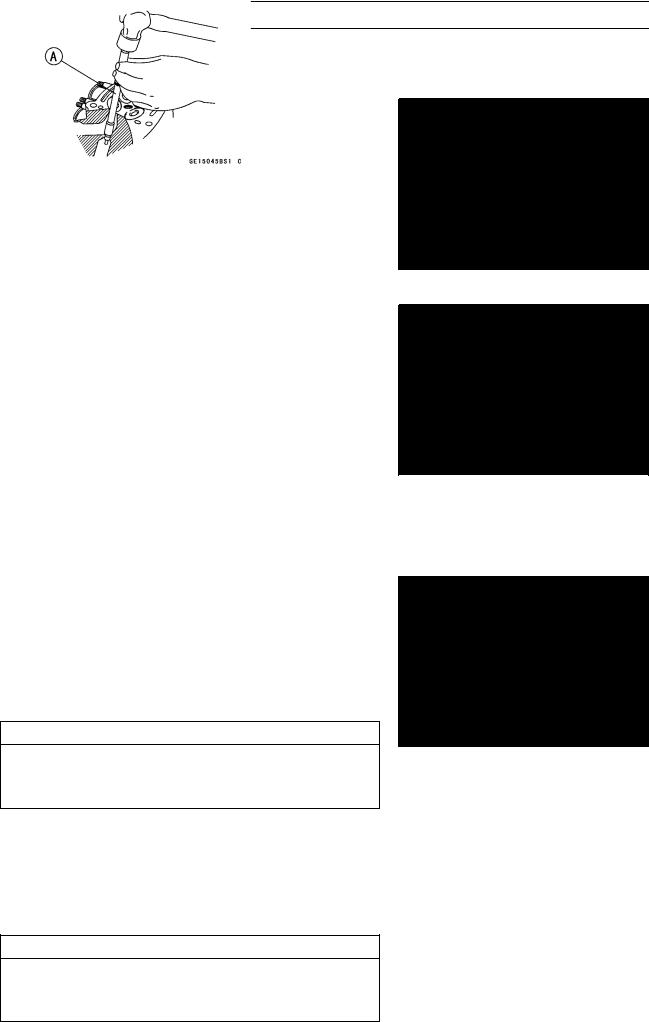
ENGINE TOP END 5-29
Valves
Valve Clearance Inspection
•Refer to the Valve Clearance Inspection in the Periodic Maintenance chapter.
Valve Removal
•Remove the cylinder head (see Cylinder Head Removal).
•Remove the valve lifter and shim.
○Mark and record the valve lifter and shim locations so they can be installed in their original positions.
•Using the valve spring compressor assembly, remove the valve.
Special Tools - Valve Spring Compressor Assembly [A]:
57001-241
Valve Spring Compressor Adapter,  20 [B]:
20 [B]:
57001-1154
Valve Installation
•Replace the oil seal with a new one.
•Apply a thin coat of molybdenum disulfide grease to the valve stem before valve installation.
•Install the springs so that the closed coil end faces downwards.
Valve Stem [A] Oil Seal [B] Spring Seat [C]
Closed Coil End [D] Valve Spring [E]:
EX - Brown Paint
IN - Light Green Paint Retainer [F]
Split Keepers [G]
Valve Guide Removal
•Remove:
Valve (see Valve Removal) Oil Seal
Spring Seat
•Heat the area around the valve guide to 120 150°C (248302°F), and hammer lightly on the valve guide arbor [A] to remove the guide from the top of the head.
CAUTION
Do not heat the cylinder head with a torch. This will warp the cylinder head. Soak the cylinder head in oil and heat the oil.
Special Tool - Valve Guide Arbor,  4: 57001-1273
4: 57001-1273
Valve Guide Installation
•Apply engine oil to the valve guide outer surface before installation.
•Heat the area around the valve guide hole to about 120 150°C (248 302°F).
CAUTION
Do not heat the cylinder head with a torch. This Will warp the cylinder head. Soak the cylinder head and heat the oil.
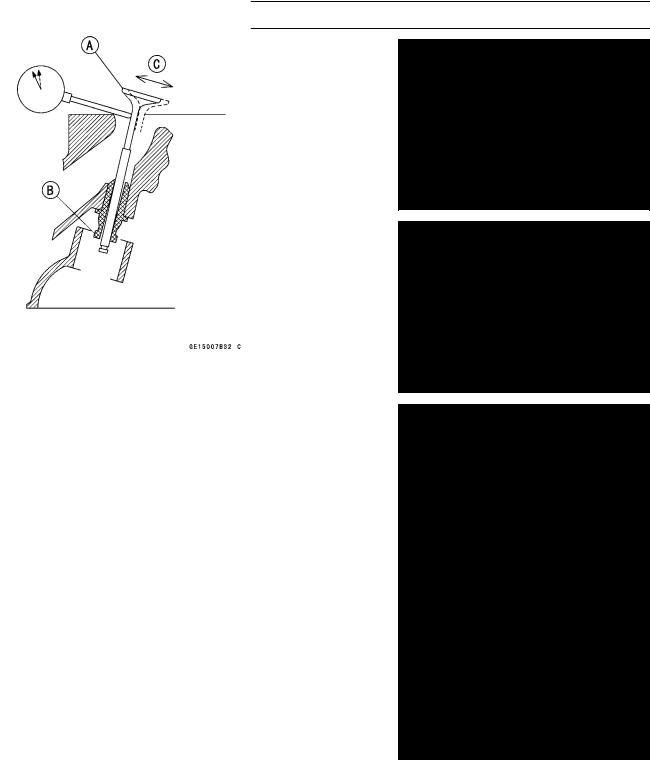
5-30 ENGINE TOP END
Valves
•Using the valve guide driver and attachment [A], press and insert the valve guide in until the attachment surface
[B]touches the head surface [C].
13.313.5 mm (0.52 0.53 in.) [D]
Special Tools - Valve Guide Driver: 57001-1564
Attachment C: 57001-1624
•Ream the valve guide with valve guide reamer [A], even if the old guide is reused.
Special Tool - Valve Guide Reamer,  4: 57001-1274
4: 57001-1274
Valve-to-Guide Clearance Measurement (Wobble Method)
If a small bore gauge is not available, inspect the valve guide wear by measuring the valve to valve guide clearance with the wobble method as indicated below.
•Insert a new valve [A] into the guide [B] and set a dial gauge against the stem perpendicular to it as close as possible to the cylinder head mating surface.
•Move the stem back and forth [C] to measure valve/valve guide clearance.
•Repeat the measurement in a direction at a right angle to the first.
 If the reading exceeds the service limit, replace the guide.
If the reading exceeds the service limit, replace the guide.
NOTE
○The reading is not actual valve/valve guide clearance because the measuring point is above the guide.
Valve/Valve Guide Clearance (Wobble Method)
Standard: |
|
|
|
Exhaust |
0.08 |
0.16 mm (0.0031 |
0.0063 in.) |
Inlet |
0.03 |
0.10 mm (0.0012 |
0.0039 in.) |
Service Limit: |
|
|
|
Exhaust |
0.40 mm (0.016 in.) |
|
|
Inlet |
0.34 mm (0.013 in.) |
|
|
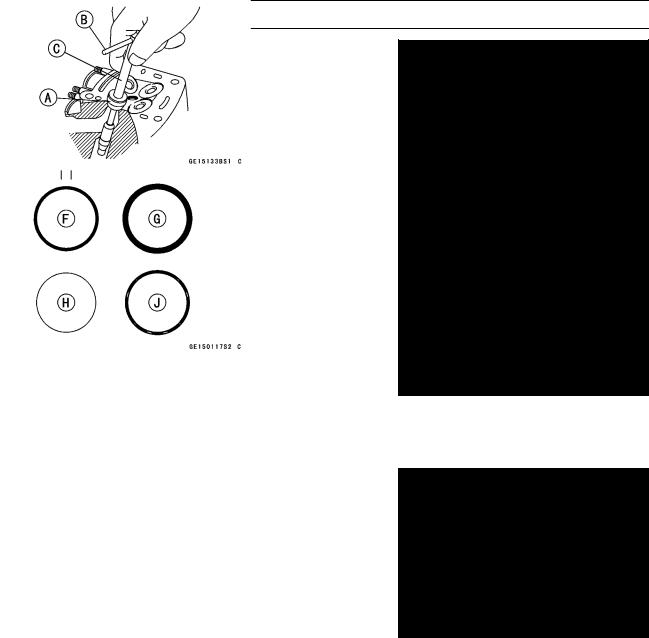
ENGINE TOP END 5-31
Valves
Valve Seat Inspection
•Remove the valve (see Valve Removal).
•Check the valve seating surface [A] between the valve [B] and valve seat [C].
○Measure the outside diameter [D] of the seating pattern on the valve seat.
 If the outside diameter is too large or too small, repair the seat (see Valve Seat Repair).
If the outside diameter is too large or too small, repair the seat (see Valve Seat Repair).
Valve Seating Surface Outside Diameter
Standard:
Exhaust |
22.8 |
23.0 mm (0.898 0.906 in.) |
Inlet |
26.93 |
27.13 mm (1.060 1.068 in.) |
○Measure the seat width [E] of the portion where there is no build-up carbon (white portion) of the valve seat with a vernier caliper.
Good [F]
 If the width is too wide [G], too narrow [H] or uneven [J], repair the seat (see Valve Seat Repair).
If the width is too wide [G], too narrow [H] or uneven [J], repair the seat (see Valve Seat Repair).
Valve Seating Surface Width
Standard:
Exhaust |
0.8 |
1.2 mm (0.031 |
0.047 in.) |
Inlet |
0.5 |
1.0 mm (0.020 |
0.039 in.) |
Valve Seat Repair
•Repair the valve seat with the valve seat cutters [A].
Special Tools - Valve Seat Cutter Holder Bar [B]: 57001 -1128
Valve Seat Cutter Holder,  4 [C]: 57001-1275
4 [C]: 57001-1275
[For Exhaust Valve Seat]
Valve Seat Cutter, 45° -  24.5: 57001-1113
24.5: 57001-1113
Valve Seat Cutter, 32° -  25: 57001-1118
25: 57001-1118
Valve Seat Cutter, 60° -  25: 57001-1328
25: 57001-1328
[For Inlet Valve Seat]
Valve Seat Cutter, 45° -  30: 57001-1187
30: 57001-1187
Valve Seat Cutter, 32° -  30: 57001-1120
30: 57001-1120
Valve Seat Cutter, 60° -  27: 57001-1409
27: 57001-1409
 If the manufacturer’s instructions are not available, use the following procedure.
If the manufacturer’s instructions are not available, use the following procedure.
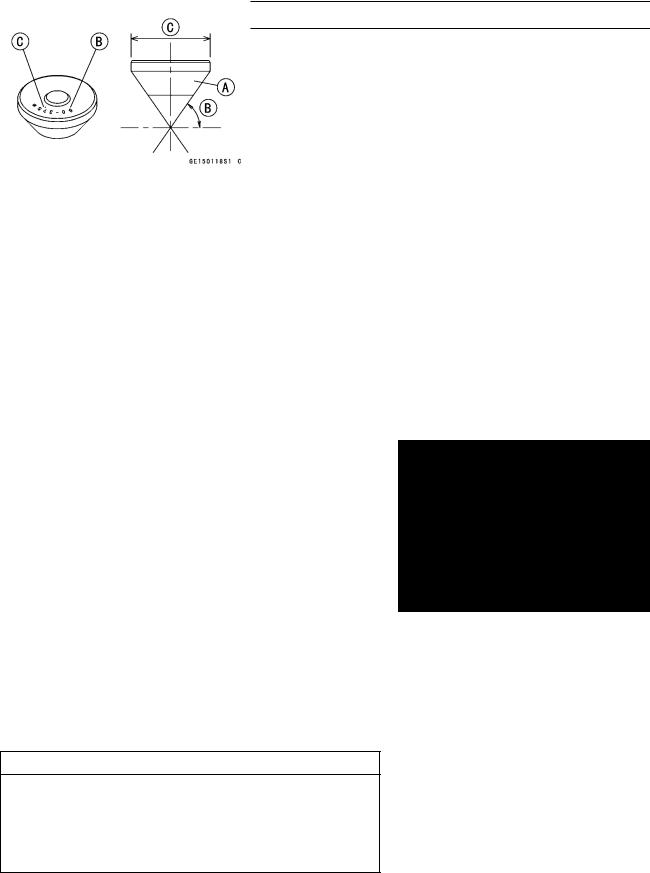
5-32 ENGINE TOP END
Valves
Seat Cutter Operation Care
1.This valve seat cutter is developed to grind the valve for repair. Therefore the cutter must not be used for other purposes than seat repair.
2.Do not drop or shock the valve seat cutter, or the diamond particles may fall off.
3.Do not fail to apply engine oil to the valve seat cutter before grinding the seat surface. Also wash off ground particles sticking to the cutter with washing oil.
NOTE
○Do not use a wire brush to remove the metal particles from the cutter. It will take off the diamond particles.
4.Setting the valve seat cutter holder in position, operate the cutter in one hand. Do not apply too much force to the diamond portion.
NOTE
○Prior to grinding, apply engine oil to the cutter and during the operation, wash off any ground particles sticking to the cutter with washing oil.
5.After use, wash it with washing oil and apply thin layer of engine oil before storing.
Marks Stamped on the Cutter
The marks stamped on the back of the cutter [A] represent
the following. |
|
||
60° ........................... |
|
|
Cutter angle [B] |
37.5 |
|
|
Outer diameter of cutter [C] |
|
....................... |
||
Operating Procedures
•Clean the seat area carefully.
•Coat the seat with machinist’s dye.
•Fit a 45° cutter into the holder and slide it into the valve
guide.
•Press down lightly on the handle and turn it right or left. Grind the seating surface only until it is smooth.
CAUTION
Do not grind the seat too much. Overgrinding will reduce valve clearance by sinking the valve into the head. If the valve sinks too far into the head, it will be impossible to adjust the clearance, and the cylinder head must be replaced.
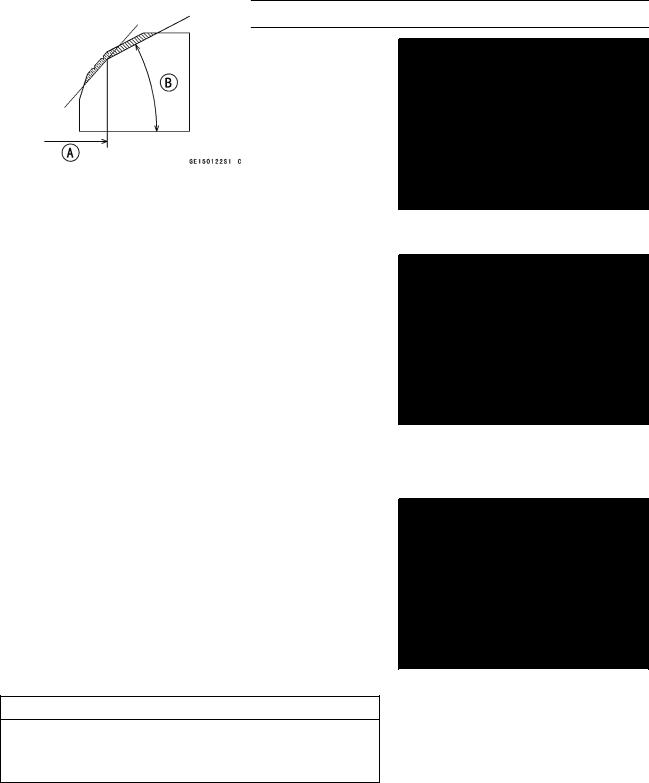
ENGINE TOP END 5-33
Valves
•Measure the outside diameter of the seating surface with a vernier caliper.
 If the outside diameter of the seating surface is too small, repeat the 45° grind until the diameter is within the specified range.
If the outside diameter of the seating surface is too small, repeat the 45° grind until the diameter is within the specified range.
Widened Width [A] of engagement by machining with 45° cutter
Ground Volume [B] by 32° cutter 32° [C]
Correct Width [D]
Ground Volume [E] by 60° cutter 60° [F]
•Measure the outside diameter of the seating surface with a vernier caliper.
 If the outside diameter of the seating surface is too small, repeat the 45° grind [A] until the diameter is within the specified range.
If the outside diameter of the seating surface is too small, repeat the 45° grind [A] until the diameter is within the specified range.
Original Seating Surface [B]
NOTE
○Remove all pittings of flaws from 45° ground surface. ○After grinding with 45° cutter, apply thin coat of machin-
ist’s dye to seating surface. This makes seating surface distinct and 32° and 60° grinding operation easier.
○When the valve guide is replaced, be sure to grind with 45° cutter for centering and good contact.
 If the outside diameter [A] of the seating surface is too large, make the 32° grind described below.
If the outside diameter [A] of the seating surface is too large, make the 32° grind described below.
 If the outside diameter of the seating surface is within the specified range, measure the seat width as described below.
If the outside diameter of the seating surface is within the specified range, measure the seat width as described below.
•Grind the seat at a 32° angle [B] until the seat outside diameter is within the specified range.
○To make the 32° grind, fit a 32° cutter into the holder, and slide it into the valve guide.
○Turn the holder one turn at a time while pressing down very lightly. Check the seat after each turn.
CAUTION
The 32° cutter removes material very quickly. Check the seat outside diameter frequently to prevent overgrinding.
○After making the 32° grind, return to the seat outside diameter measurement step above.
•To measure the seat width, use a vernier caliper to measure the width of the 45° angle portion of the seat at several places around the seat.
 If the seat width is too narrow, repeat the 45° grind until the seat is slightly too wide, and then return to the seat outside diameter measurement step above.
If the seat width is too narrow, repeat the 45° grind until the seat is slightly too wide, and then return to the seat outside diameter measurement step above.
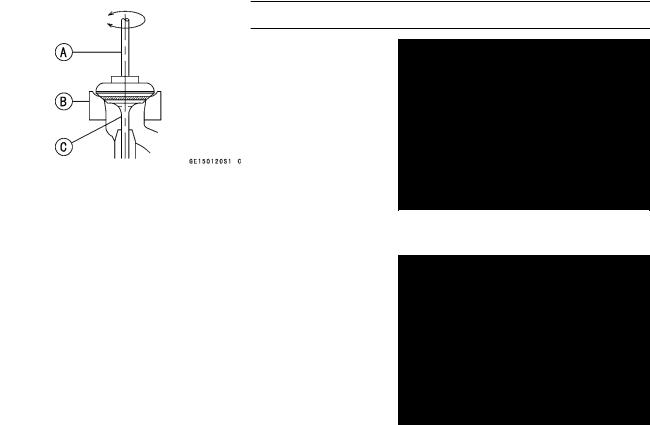
5-34 ENGINE TOP END
Valves
 If the seat width is too wide, make the 60° [A] grind described below.
If the seat width is too wide, make the 60° [A] grind described below.
 If the seat width is within the specified range, lap the valve to the seat as described below.
If the seat width is within the specified range, lap the valve to the seat as described below.
•Grind the seat at a 60° angle until the seat width is within the specified range.
○To make the 60° grind, fit 60° cutter into the holder, and slide it into the valve guide.
○Turn the holder, while pressing down lightly.
○After making the 60° grind, return to the seat width measurement step above.
Correct Width [B]
•Lap the valve to the valve seat, once the seat width and outside diameter are within the ranges specified above.
○Put a little coarse grinding compound on the face of the valve in a number of places around the valve head.
○Spin the valve against the seat until the grinding compound produces a smooth, matched surface on both the seat and the valve.
○Repeat the process with a fine grinding compound. Lapper [A]
Valve Seat [B] Valve [C]
•The seating area should be marked about in the middle of the valve face.
 If the seat area is not in the right place on the valve, check to be sure the valve is the correct part. If it is, it may have been refaced too much; replace it.
If the seat area is not in the right place on the valve, check to be sure the valve is the correct part. If it is, it may have been refaced too much; replace it.
•Be sure to remove all grinding compound before assembly.
•When the engine is assembled, be sure to adjust the valve clearance (see Valve Clearance Inspection in the Periodic Maintenance chapter).
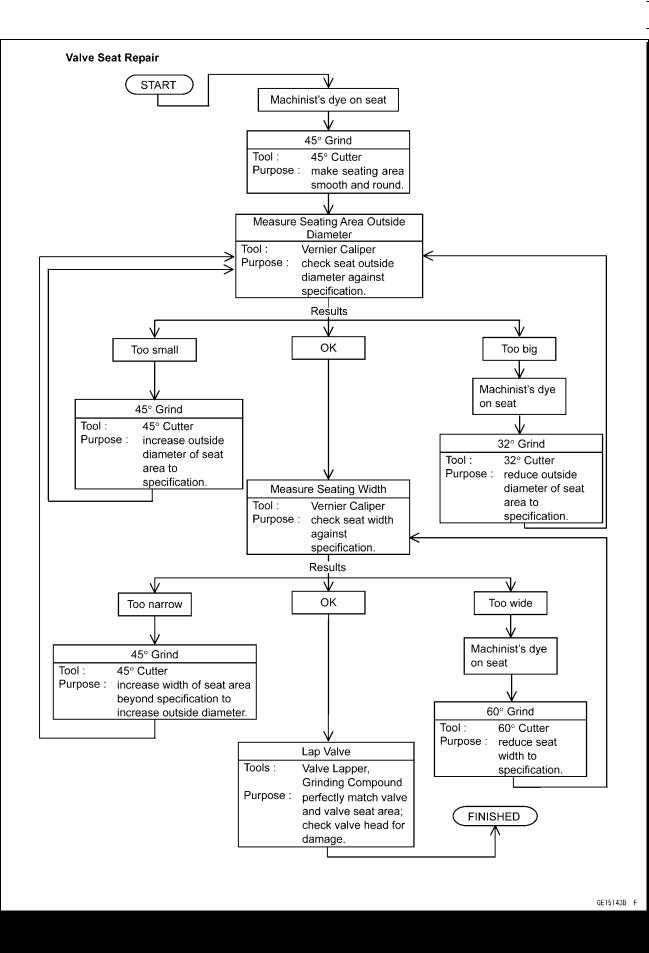
ENGINE TOP END 5-35
Valves
